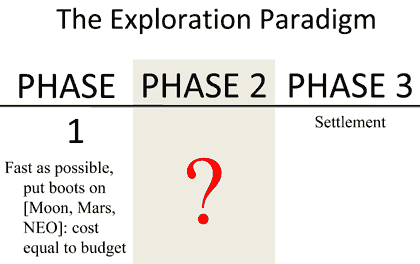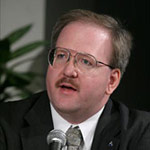Jeff Greason’s speech at the Awards Dinner at the 2011 NSS International Space Development Conference is being widely regarded as a major statement in the field of space policy. A video of the speech is now on the NSS website.
Greason is President of XCOR Aerospace and was a member of the Augustine Committee (Review of U.S. Human Space Flight Plans Committee) established by the White House in 2009. He began his talk by defining the differences between goals, strategies, objectives, and tactics.
“Between having a goal and having tactics, you have to have a strategy — and we don’t. Until we have one, we’re going to continue to flail.”
We do have a goal, says Greason. Although it’s not widely recognized, it can be found in nearly every major policy document and commission report over the last 25 years. The Augustine Report, for example, “concludes that the ultimate goal of human exploration is to chart a path for human expansion in to the solar system.” But none of them quite dare use the “S” word, even though that’s what they are really talking about — [whisper] settlement. The reason they don’t dare use the word is they are not sure we can do it.
This point is illustrated in one of Greason’s slides about the lack of a strategy for settlement:

Greason then laid out — nondogmatically, as one of many possible approaches — his ideas for a possible strategy. “The purpose of the initial human outpost is not to be there and look cool. It is not to unfurl flags and take pretty pictures, and it is not the holy grail of science, although we will get all of those things. It’s to make gas.” Basically, each destination has the resources to make propellant to help reach the next destination — a strategy he calls “Planet Hopping.”
Greason includes the following elements of a strategy for space settlement:
* The key is to realize that cost per human being in space MUST constantly decrease in order to succeed.
* Each capability we add MUST be designed from the outset to transition to a private sector supported activity. Only in that way can we add new capabilities with constant budget.
* Each step forward must make maximum use of in-situ resources, both to lower cost of operations and to provide low cost resources to support next steps. This allows for exponential growth over time rather than linear.
Greason also pointed out that we have to realize that NASA’s budget is not going to go up. However, he added “It’s my belief that if we pursued this the right way, we actually could afford to do this, all the way out to the first landings on Mars, for the kind of budget NASA’s getting now.”
But Greason warned that if we continue on the current path, without a strategy, “we’re going to build a big rocket, and then we’re going to hope a space program shows up to fly on it. And in my opinion, that strategy — the strategy of default — is going to result in the end of the NASA human spaceflight program.”




















2 thoughts on “ISDC 2011 Keynote Speech – Jeff Greason – A Settlement Strategy for NASA”
The preceding post on this blog deals with two possible ways of creating the “settlement” infrastructure that Jeff Greason calls for herein. Dr. Spudis makes a cogent argument for the first step being the mining of lunar ice to create water, oxygen, LOX and H2 for fuel and selling these products commercially in the cis-lunar territory.
One of the main points that Jeff made in his talk can be expressed in another way. Prioritizing the production of propellants at each new base site means accepting the principle of using integrated base-vehicle systems with each base supporting the vehicle’s operation and the vehicles supporting the base’s operation, the same way the components of a car or animal work together. The car or the animal will not work without all of its components. The synergy of this concept is critical to enhanced access to both the Moon and Mars and could reduce costs allowing access to both destinations within a short period of time.
I agree very much with almost all of Jeff’s other points. About the only one I might disagree with is on a purely technical and pragmatic basis. He proposes to use Phobos as an initial source of fuel for access to the Mars system. With the recent discovery of probable water ice deposits within 25 degrees of Mars equator, it is now possible to migrate directly from methane-oxygen to using hydrogen-oxygen propellants, made from the Mars ice. This provides a 3-fold increase in payload to Mars orbit from the surface of Mars, and opens up the rest of the Mars system to exploration. With a 38% gravity, most or all of the fuel production equipment can be modified for use on Mars from existing Mars equipment, without needing to develop a microgravity fuel production infrastructure. This would allow a much more rapid advance to Mars than is currently envisioned, which assumes we have to create the microgravity systems first.
John